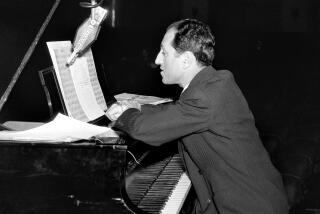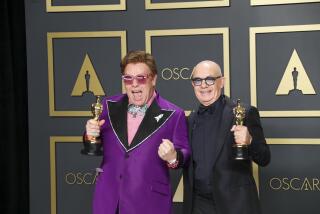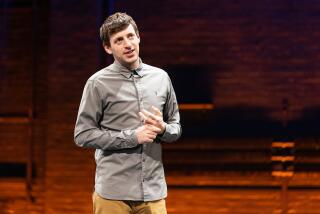The Yiddish Gershwin
- Share via
In “Gershwin the Klezmer,” writer-producer Joe Vass connects the dots of music notes and draws a picture of George Gershwin influenced by jazz, gospel and Yiddish music.
The production, which comes to Cal State Northridge on Saturday and Sunday, chronicles the life and music of Gershwin (nee Jacob Gershowitz). People might expect to hear “Klezmerized” Gershwin tunes, kind of a klezmer soup, said Vass, who plays piano in the performance. Not so, he said.
“In tracing the Jewish connection in the music, we wind up playing gospel, jazz, Yiddish songs and plenty of great Gershwin tunes,” he said. “When I first heard Gershwin’s music, it made me think of Jewish music. But the more I listened and studied, the more I found actual rhythms, scales and melodies directly from the Jewish tradition.”
Klezmer refers to the Yiddish custom of an informal group of musicians going from village to village in Eastern Europe playing traditional music, folk songs and prayer hymns. Klezmer music is played on trumpets, bugles, flutes, clarinets, fifes, violins, cellos and drums.
Although many people recognize the influence of African American gospel music in Gershwin’s work, few folks realize the impact that Jewish music had on the musician.
“It is a missing connection in our history,” Vass said. “Not only Gershwin, but all these great Jewish-American songwriters, like Irving Berlin, they all drew on the Jewish tradition in their songs and made this great contribution to the world’s music.”
The production includes Michael Paul Levin portraying George Gershwin, the five-member Minnesota Klezmer Band and vocalists Bruce Henry, Maggie Burton and Prudence Johnson.
“Gershwin Klezmer” may be the perfect show for baby boomers and their parents. Listening to some of the tunes performed by the Minnesota Klezmer Band evokes memories of steamy kitchens and home cooking. And the bittersweet violin mastery by Yuri Merzhevsky hits the spot reserved for joy and sorrow, one that is universally understood.
“It is not just for Jews,” said Rabbi Bernard Solomon Raskas, a professor of religious studies at Macalaster College in St. Paul, Minn. “It is for everyone who is interested in the process of America and the way it includes in its repertoires various backgrounds.”
To artistically demonstrate the cultural connections, Vass juxtaposes music styles. One is a jazz-gospel influence and the other a phantom-like reminder of Gershwin’s upbringing.
“I recognized immediately in ‘It Ain’t Necessarily So’ that the melody is the one traditionally used to recite the blessing over the Torah,” Raskas said. “He linked jazz from the African American experience and fused that with the Jewish experience.”
The Rev. Christopher Trussell, drama director at Cathedral High School in St. Cloud, Minn., said he never considered Gershwin in an ethnic light until he saw a performance of “Gershwin the Klezmer.”
“It gave a completely new sense of what he was all about,” Trussell said.
BE THERE
“Gershwin the Klezmer,” Saturday at 3 and 7:30 p.m. and Sunday at 3 and 7 p.m. $29 general admission. Call (818) 785-8885.
More to Read
The biggest entertainment stories
Get our big stories about Hollywood, film, television, music, arts, culture and more right in your inbox as soon as they publish.
You may occasionally receive promotional content from the Los Angeles Times.










